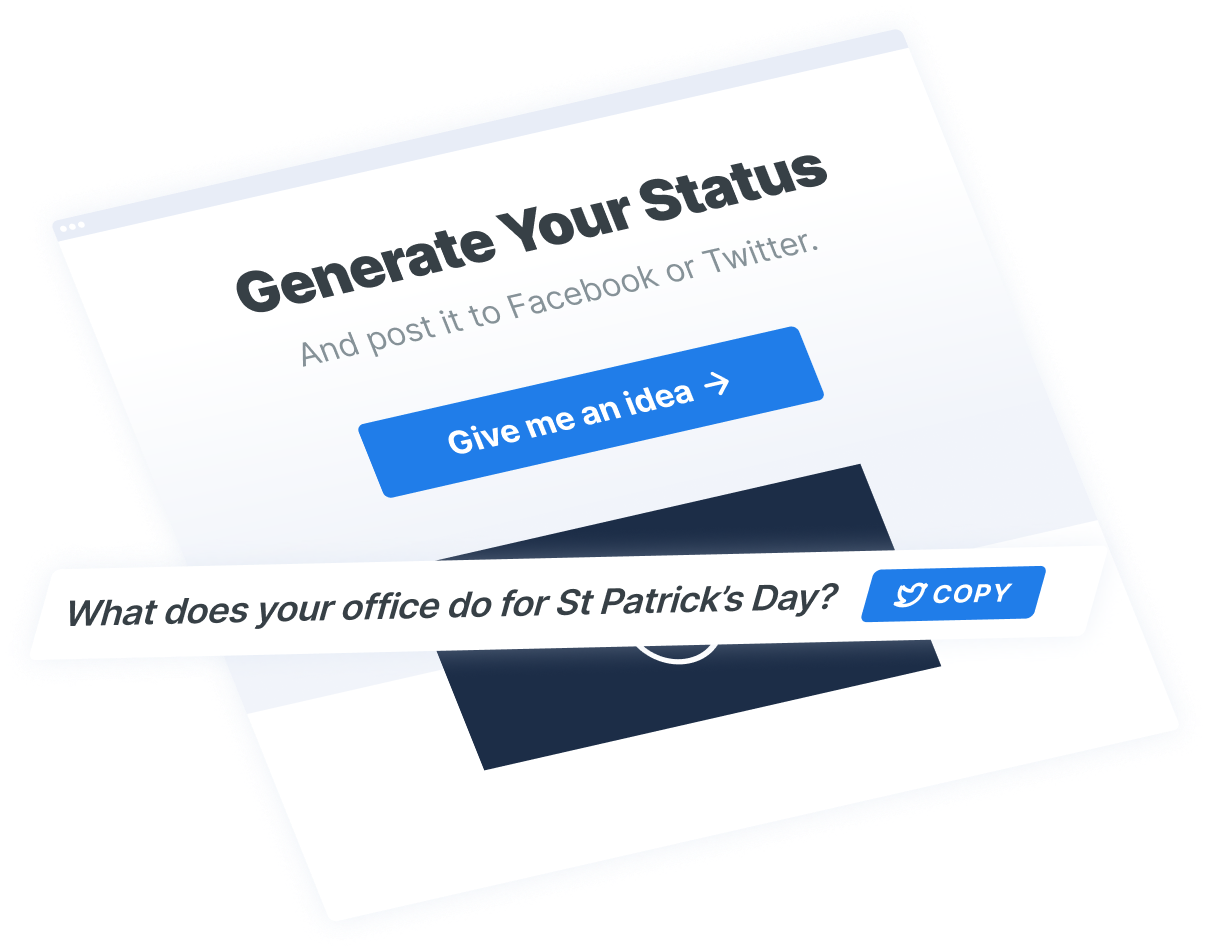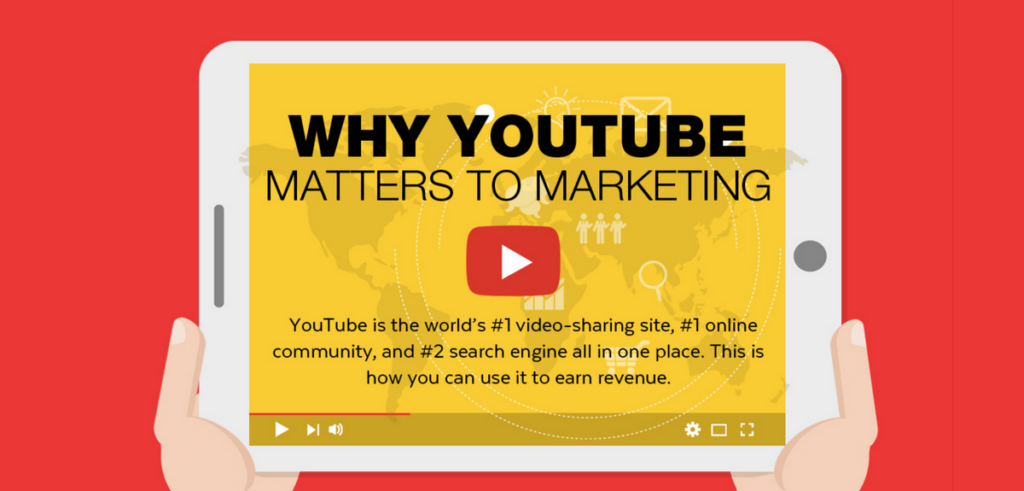- Home
- Blog
- Social Media
- Why YouTube Matters to Marketing [INFOGRAPHIC]
Why YouTube Matters to Marketing [INFOGRAPHIC]
-
 15 min. read
15 min. read
-
 WebFX Team
WebFX Team Digital Marketing Agency
Digital Marketing Agency
- The WebFX team is made up of more than 500 subject matter experts in digital marketing, SEO, web design and web development, social media, and more. Together, they’ve helped WebFX’s clients earn more than $6 billion in revenue from the web — and that’s just in the past five years. @webfx
YouTube is the world’s largest video-sharing community. With billions of users and new content uploaded every second, it’s an online entertainment powerhouse with 10 times the users of Netflix, Amazon Prime, and Hulu combined.
What does the world’s biggest video site offer marketing? A lot more than you might expect.
YouTube — and parent company Google — is the second-most popular website in the world. It’s even become a career for some intrepid self-starters who maintain their own YouTube channels. Some brands even choose to monetize their channels to bring in extra revenue every year.
But even if you’re just starting your online marketing strategy, you can still profit from YouTube. How? Just check out our infographic below!

1. YouTube information and growth
Before you can market on YouTube, you have to understand YouTube’s background.
First, YouTube was founded in May 2005. So when you compare it to other businesses, it’s not that old — even for Internet companies. Google picked it up for a cool $1.65 billion on November 13, 2006.
Currently, YouTube’s worth has appreciated to $86.22 billion. That’s a 5225% increase in value, which is almost unbelievable. That acquisition and steep increase in value is largely thanks to one video — “BSB” by nitroxunit.
This video features two people lip-syncing to a Backstreet Boys song while a third person sits in the background on their computer (he’s actually in every video).
The video was a viral hit. YouTube CEO Susan Wojcicki said that after she saw “BSB,” she knew Google had to get YouTube on board. In hindsight, Wojcicki’s idea was brilliant.
YouTube was estimated to bring in $4.28 billion during 2015, though it’s also rumored that Google runs YouTube at a loss. (It’s also bizarre to consider how many companies would love to have $4.28 billion in revenue, but it barely scratches the surface of Google’s income from AdWords.) But YouTube has come a long way from the days of nitroxunit. To successfully market on YouTube, you have to understand its modern users.
2. YouTube Users
YouTube’s users are notoriously young. Many grew up with YouTube before it was purchased by Google and before it was monetized.
Today, YouTube’s total userbase includes more than 1 billion people, and at least half of them use YouTube on mobile. On average, each one of them spends 40 minutes on YouTube every time they log on.
That’s a phenomenal dwell time. You’ll only find numbers like that on other big-name sites like Facebook. But those billion users watch more than 4 billion videos every day.
The most watched video is “Gangnam Style” by Psy, a South Korean artist known best for his strange music video and iconic dance. It’s been viewed 2.7 billion times total. The most liked video, on the other hand, is “See You Again” by Wiz Khalifa.
It’s been viewed 12.6 million times, but it has 97% likes and 3% dislikes. Likes and dislikes are the social media shares of YouTube that act kind of like upvotes on Reddit. The more likes a video has, the more views it’ll get.
Dislikes act like just the opposite. Justin Bieber’s “Baby” is the most disliked video on YouTube. 57% of the video’s 7 million views are dislikes. Considering Bieber got his start on YouTube, this is a solid sign of the fickleness behind YouTube’s users. It’s smart to keep this example in mind as a brand because it shows just how careful you have to be when navigating YouTube’s userbase.
You can have a great start on YouTube — but popular sentiment can change at any time.
3. Popular YouTube channels
Much like television channels, some YouTube channels are more popular than others.
The #1 YouTuber is PewDiePie, real name Felix Arvid Ulf Kjellberg. Kjellberg has more than 52 million subscribers or 5% of all YouTube users, that follow his let’s-play style videos about video games. Most interviews with Kjellberg ask him about how much money he makes from monetizing his channel, but he rarely (if ever) answers.
He’s estimated to have a “salary” of several million dollars at age 27. Kjellberg’s legacy on YouTube is simple — people love video games. HolaSoyGerman is the #2 most popular YouTube channel overall (and the #1 non-English channel) with 30 million subscribers. His real name is German Alejandro Garmendia Aranis, and he primarily works in comedy.
Like Kjellberg, Aranis is suspected of earning upward of seven figures every year. He’s 26 years old, and his channel proves both the demands of non-English speaking YouTubers and the value of online comedy. JustinBieberVEVO is the next-most popular channel with 26 million subscribers.
Despite its name, this channel is not run by Bieber (like his original channel). Instead, it’s run by VEVO, which is a collaboration of Universal Music Group, Google, Sony, and Abu Dhabi Media. As a result, VEVO has a huge lineup of popular music artists.
VEVO posts their music videos to YouTube monetizes them with ads and rakes in millions each year from its subscribers. This is our first example of a brand properly marketing and monetizing itself on YouTube. With it, VEVO validates the potential for YouTube brand marketing.
The #4 channel on YouTube is YouTube itself. With 25 million subscribers, YouTube posts updates about the company, YouTube Rewind compilations, and social awareness pieces. YouTube is the only channel on this list that does not monetize its subscribers — which makes sense.
It’d be a waste of time for YouTube to pay itself for ads. The last channel in the top five is RihannaVEVO. Just like the Bieber version, this is a licensed version of Rihanna’s music videos.
It has 23 million subscribers in total. The point of Rihanna’s channel is similar to Bieber’s — pop stars can still make a lot of money, even in an age of Internet piracy. The bottom line is simple: If these channels can earn money from YouTube, so can you.
But how?
4. YouTube marketing best practices
Like every other marketing format, YouTube has a list of best practices you should use to reach as many users as possible.
To start your YouTube marketing campaign, you have to make a channel. Naming your channel is one of the most important parts of marketing. Just like with your website, your YouTube channel will become major support of your brand, what you value, and what you do.
1. Use your brand name
That’s why it’s so important to use your brand name in your channel name. In fact, if you’re lucky enough, you might be able to just use your brand name. If someone already has that name, you can use your brand name followed by your industry.
So say PNC Bank couldn’t grab the channel name “PNC.” Instead, they could choose PNCBank, PNCNational, or some other variation.
2. Add keywords to channel name
Next, add keywords to your channel name. So let’s say you can’t get your brand name as your channel name. Adding extra keywords, like “PNCBank,” will help your potential customers find you based on more general YouTube searches.
This is especially important because YouTube is the second-largest search engine in the world. If you want to show up in searches for 1 billion users, you have to use keywords.
3. Use keywords in video titles
In addition to using keywords in your channel name, keywords are essential in your video titles. These keywords have the same purpose in your titles as in your channel name. They let you show up for general terms someone’s searching in YouTube, which is probably how most people will find your brand.
Every time you add a video, you have the chance to rank for yet another keyword — just like SEO in Google!
4. Add a brand name to video titles
Your brand name is essential in video titles. It’ll make sure that when someone searches your brand, they won’t just find your channel — they’ll be able to see your entire library of videos in search results. Whether they scroll through those videos is up to them.
But it’s a great way to show someone new that you have a lot of knowledge and a whole lot more to offer!
5. Consistently brand videos with intro or logo
When you create a channel for your brand, it’s important that you reinforce your company’s image with a consistently branded intro or logo. This can be a simple logo in the bottom right of the video. You could also add a short, 10-second intro to each video that features your logo prominently on the screen.
Regardless of your choice, you’ll have consistency in your videos that’ll tell viewers that they’re watching something from you.
6. Use Audience Retention Report
One of YouTube’s many resources for channels is the Audience Retention Report.
The Audience Retention Report is the analytics platform for your YouTube videos. It shows how many people view your videos and how long they watched in a certain timeframe. You can also check out the countries where people view your videos the most and which videos are the most popular.
Overall, you have a lot of raw data in this one report that can guide your future YouTube marketing strategy — just like how Google Analytics guides SEO strategies.
7. Update channel regularly
If you want to get results from YouTube in the long-term, you have to update your channel regularly. That means creating a schedule for publishing videos on your channel. So if you want to post videos weekly, choose a day of the week that works for your business.
Then, add new videos to your channel on that day every week, preferably at the same time. Regularity lets your viewers know when to expect updates from you. It’s kind of like tuning in to your favorite TV show at the same time every evening.
You know when it’s on, and you know it’ll be good.
8. Shoot videos 31-60 seconds long
The ideal length for a brand video is between 31 and 60 seconds. This may vary depending on your industry. If you’re an auto parts supplier trying to show someone how to change their oil, you’ll probably run a little longer than a minute.
But ideally, you want to be short and sweet. Most YouTube viewers want information, but they want it quickly. Write your video scripts to hit the shortest length possible while still giving out the information someone wants.
If you ever wonder if a video is too long, put yourself in the shoes of your viewer. Do you have five minutes to spare for a topic? Or would you watch a video that’s only 30 seconds?
This is by far one of the most challenging parts of YouTube marketing. But once you nail down a system for creating short, bite-sized videos, you can help your viewers like no other brand in your industry.
9. Share and embed videos on your site
YouTube makes it easy for you to share and embed videos. On every video you upload, you can click the “Share” button to find the embed code that lets you post a video anywhere on your site. The views for that video are tracked on YouTube just like native views.
You can also add text, images, and other videos to a page to make the page itself stronger in terms of SEO value. This strategy works exceptionally well for 10X content or any aggressive SEO strategy that targets highly-competitive keywords. Adding this multimedia to your site will help you rank better — especially if you post your video high on a page.
5. Elements of a successful YouTube video
Like other forms of marketing, successful YouTube videos have similar characteristics.
is important because it gives a sense of expectation to all of your videos. If someone wants to know whether a video is genuinely from your brand, your branded intro will reassure them. Next, your videos should only use high-definition footage.
Even if a user can’t view your video in 1080p resolution, you should still film it like that to give a great user experience to anyone — regardless of their Internet speed. Third, it’s important to use clean breaks / transitions between scenes. You can usually do this with “jump cuts,” or placing clips next to one another without any fading, gradient, or other effects.
You’ll also need clear speaking / dialogue to make sure your viewers can hear what you say. Poor audio quality can destroy a video and frustrate your viewer. Get a few microphones to make sure your viewers can always hear you.
Next, the people in your video should have a professional appearance. The details of this idea will change depending on your brand. If you’re a bank, you want to wear business formal.
If you’re a burrito joint, you can probably get away with casual dress. In terms of video content, a how-to demonstration is almost guaranteed to engage lots of viewers. Showing someone how to quickly complete a task is one of the most effective YouTube marketing formats for promoting your brand.
Finally, add a call to action to the end of your video. That call to action could urge someone to subscribe to your channel, check out your site, or buy a product. Regardless of what you want them to do, make sure you clearly state it at the end of the video.
6. Brands on YouTube
If you’re the type of person who learns through example, these are some of the most successful brands on YouTube.
First, 61% of enterprise-level companies use YouTube for marketing. So if you’re in the 39% of enterprises that doesn’t, you have a lot of catch-up work ahead of you. On the flip side, only 9% of small businesses use YouTube for marketing.
In other words, if you’re a local company, YouTube is an absolute goldmine in terms of reaching potential customers. There’s a 91% chance that you won’t have any competition! The most popular brand channel on YouTube is Red Bull with 5.68 million subscribers.
In addition to making energy drinks, Red Bull has diversified its business model to include video game tournaments, extreme sports, and other youthful hobbies. While these initiatives may not pay Red Bull directly, the exposure they get — plus the YouTube content they generate — yields overall sales increases. In that regard, what’s good for YouTube is also good for business.
Next, the most popular brand genre on YouTube is how-to videos. We’ve talked about these before, but it’s important to emphasize that they’re in demand right now. And to be honest, they’ll probably be in demand for years to come.
Everyone always wants to know how to do something. You should be the one to teach them! Most importantly, YouTube converts more customers than any other social outlet.
This could be for any number of reasons, but it’s probably because video is a naturally-engaging content format. Plus, you can easily share links to your videos on other social networks, which brings everyone back to YouTube and then your brand. So if you want more customers, YouTube is the place to do it.
7. YouTube ad successes
In addition to running a free channel, you can also pay for ads on YouTube. We’ll touch on ads format in a second. For now, let’s take a look at whether they work.
ZAGG is a mobile accessories conglomerate that sells everything from smartphone battery packs to cell phone car mounts.
Their ads were all videos that featured product demos and installation tips. While those may not sound like great commercial ideas — you probably won’t see them on television, anyway — they earned ZAGG a 75% increase in conversions on targeted videos. Next, Revzilla is a motorcycle accessories retailer that produced product demos and motorcycle safety tips.
The results were 7 million views, which is an incredible achievement for any brand. Those views also translated to new customer conversions, which gave the company a 50% increase in revenue. Last, we have The BBQ Guys.
This brand is a simple foodservice retailer that just showed people how to cook, season, and otherwise work a barbecue. They created product demos (that included food) and wound up earning more than 4500 daily views every day. That’s 4500 new potential customers watching a video from their brand every day.
It’s almost impossible to find that level of exposure anywhere else in marketing.
8. YouTube paid ads
YouTube’s advertising options cover a huge range of options. That empowers virtually any company to create an ad for somewhere on YouTube.
On average, YouTube charges about 10-30 cents for every 1000 views or interactions on an ad. We say “views or interactions” because the payment basis depends on your ad’s format.
are your first option.
These are static images that show up next to the video for desktop users only. You pay for these ads based on CPM or click. Overlay is an ad image that shows in the bottom 20% of a video’s window.
It doesn’t work on mobile devices, TVs, or video game consoles, and viewers can dismiss it whenever they’d like. You only pay for this ad when someone clicks on it.
You can also use bumper ads on YouTube. These are ultra-short, 6-second ads that viewers can’t skip.
You pay for them on a CPM basis. Midroll refers to full-length commercials at the beginning, middle, or end of a video. You can pay YouTube for these based on CPM or whenever a user watches at least 30 seconds of the ad.
TrueView ads are 15-second commercials at the beginning, middle, or end of a video that users can’t skip. You can pay for them based on CPM or clicks. Finally, native mobile ads are promotional pieces made for mobile devices only.
You pay for them based on CPM or clicks. With that, you’re now fully equipped with the knowledge to run a successful YouTube marketing campaign. Get out there and spread the word about your brand!
Share the infographic (and the wealth)
Does your business use YouTube for marketing?
Now’s the time to start! Spread the word on Facebook and Twitter — YouTube is the customer and lead-gen resource for all things video!
-
 The WebFX team is made up of more than 500 subject matter experts in digital marketing, SEO, web design and web development, social media, and more. Together, they’ve helped WebFX’s clients earn more than $6 billion in revenue from the web — and that’s just in the past five years.@webfx
The WebFX team is made up of more than 500 subject matter experts in digital marketing, SEO, web design and web development, social media, and more. Together, they’ve helped WebFX’s clients earn more than $6 billion in revenue from the web — and that’s just in the past five years.@webfx -

WebFX is a full-service marketing agency with 1,100+ client reviews and a 4.9-star rating on Clutch! Find out how our expert team and revenue-accelerating tech can drive results for you! Learn more
Twitter and Facebook Status Generator
Finding engaging social media content for your business can be difficult. Use our tool to quickly find ideas and post directly to your page.
Give Me an Idea

Social Media Success Story

Proven Marketing Strategies
Twitter and Facebook Status Generator
Finding engaging social media content for your business can be difficult. Use our tool to quickly find ideas and post directly to your page.
Give Me an Idea
What to read next





